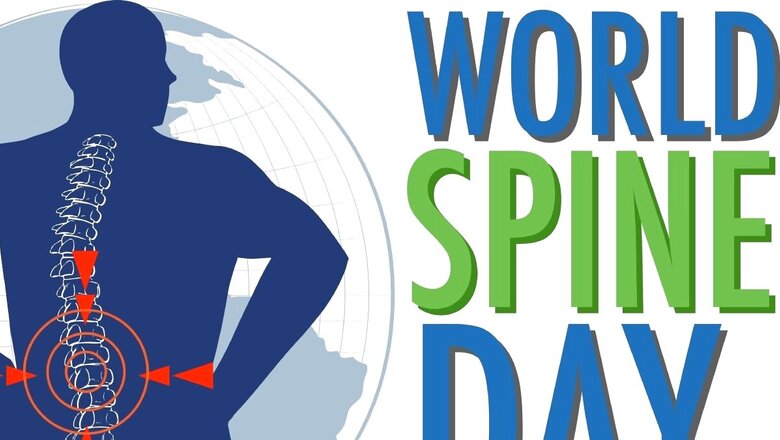
views
The shift to remote work has fundamentally transformed our daily routines. While this transition offers flexibility, it has also led to a noticeable rise in spine-related issues, especially back pain. With more people working from home in less-than-ideal ergonomic setups, it’s crucial to understand how to maintain a healthy spine in this new environment.
The Problem: Poor Ergonomics and Sedentary Lifestyles
Dr Ashish Gupta, Senior Director of Neurosurgery and Spine Surgery at Max Super Speciality Hospital Patparganj, highlights the major culprits behind this surge in back pain. “Many home setups lack the ergonomic features of an office. Desks may be too low or too high, and chairs may not provide adequate support. The convenience of working from home can lead to longer periods of sitting, which weakens core muscles and contributes to back pain,” he explains.
Adding to the concern, Dr Rajesh Verma, Director of the Department of Orthopedics & Spine Surgery at Marengo Asia Hospital Gurugram, points out that people are often sitting in uncomfortable positions on couches, mattresses, or poorly designed chairs. “Sitting in these suboptimal positions can cause back strain, eventually leading to stiffness, discomfort, and possibly chronic spinal problems,” he warns.
Addressing the Issue: Setting Up a Spine-Smart Workspace
To combat these issues, both doctors emphasize the importance of creating an ergonomically sound workspace.
- Ergonomic FurnitureDr. Gupta advises investing in proper ergonomic furniture. “Choose a chair that supports the natural curve of your spine, with adjustable height and lumbar support. A height-adjustable desk is also a good idea, as it allows you to alternate between sitting and standing throughout the day.”
- Optimize Your WorkspaceDr. Verma echoes this advice and adds that screen positioning is critical to avoiding neck strain. “Keep your computer screen at eye level. Use a monitor riser if necessary. Position your keyboard and mouse so that your elbows remain at a 90-degree angle to reduce tension on your shoulders and wrists.”
- Posture and Movement: Key to Long-Term Spine HealthMaintaining good posture while working is just as important as having the right furniture. Dr. Gupta recommends sitting back in your chair with your feet flat on the floor, keeping your shoulders relaxed, and avoiding any slumping or leaning forward. “Good posture can significantly reduce the strain on your spine,” he emphasizes.
Beyond posture, both experts agree that regular movement is vital. “Take frequent breaks to stand, stretch, and walk around. Ideally, move every 30 to 60 minutes to prevent stiffness,” says Dr. Verma. Dr. Gupta supports this, adding, “Incorporating short standing breaks or using an exercise ball for limited periods can make a difference.”
Staying Active: Building Strength to Support Your Spine
While adjusting your workspace is crucial, it is equally important to incorporate physical activity into your routine. “Engaging in regular exercise to strengthen core muscles will improve your overall back health,” notes Dr. Gupta. Exercises like yoga and Pilates, which focus on flexibility and core strength, can be particularly beneficial for maintaining spinal alignment.
Dr. Verma also stresses the importance of flexibility. “Simple stretches and yoga can relieve back strain and help improve flexibility, which is essential when you’re sitting for extended periods.”
Work-Life Balance: Protecting Your Spine and Mental Health
Finally, both doctors agree that maintaining a work-life balance is essential for both mental and physical well-being. Dr. Gupta advises setting clear boundaries between work and relaxation, emphasizing that prolonged sitting and overworking can increase stress on the spine.
Dr. Verma concurs, recommending a dedicated workstation to mentally separate work from leisure. “Having a proper workspace is not only good for your posture but also for your overall productivity and mental health,” he says.
Small Changes for Long-Term Spine Health
Remote work doesn’t have to result in chronic back pain or spinal issues. By making thoughtful adjustments to your home office setup and being proactive about your posture and movement, you can protect your spine and enjoy the benefits of a more flexible work environment.
As Dr. Gupta summarizes, “Back pain doesn’t have to be a part of the remote work experience. With simple ergonomic solutions and regular movement, you can thrive in a home office setting.” Dr. Verma adds, “By incorporating these small changes, you lessen the risk of developing chronic back issues and ensure long-term spine health.”




















Comments
0 comment